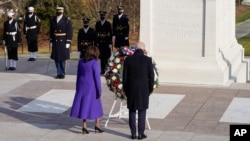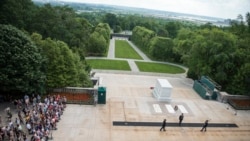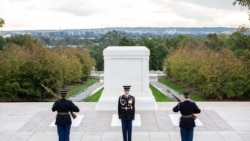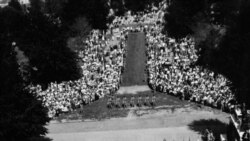"Here rests in honored glory an American soldier known but to God," says the inscription carved into the large white marble gravestone on the Tomb of the Unknown Soldier. Perched on a hillside in Arlington National Cemetery, the memorial overlooks Washington.
The tomb "is hallowed ground," said Tim Frank, a historian at the largest military cemetery in the United States, the final resting place of more than 400,000 men and women.
It is a place where people can honor not just the unknown soldier, who died during World War I, but all soldiers, known and unknown, who gave their lives in America's wars, Frank told VOA.
"It is the nation's most sacred military monument" and is guarded all the time, added historian Philip Bigler, author of Tomb of the Unknown Soldier: A Century of Honor.
Veterans Day, formerly Armistice Day, is a federal holiday observed on November 11 to pay tribute to military veterans. This year it also commemorates the 100th anniversary of the Tomb of the Unknown Soldier, which draws several million visitors each year.
There is a quiet reverence as an Army honor guard walks back and forth at the tomb in a perfectly timed pattern.
"I wasn't expecting to be so moved," said Alicia Davis, a visitor from Memphis, Tennessee. "And watching the guard protect the tomb made me realize just how many people have died for this country."
Origins of the tomb
The monument is also a reminder of the bloody history of World War I.
Millions of people died during the Great War, which took place mostly in Europe from 1914 to 1918. The U.S. suffered more than 100,000 casualties. Because many of soldiers who died could not be identified, they were laid to rest in U.S. military cemeteries in Europe.
Britain and France each buried an unknown soldier on Armistice Day in 1920, and the United States soon followed suit.
In 1921, an unknown American soldier was brought from France to Washington for burial at Arlington National Cemetery.
Instead of choosing to honor a general with a monument, all three countries selected "the unknown common soldier as a hero of World War I," Bigler said.
The unknown soldier arrived in Washington to fanfare usually reserved for dignitaries. The body lay in state at the U.S. Capitol Rotunda, where about 90,000 visitors paid their respects. Then on Armistice Day, during a ceremony to bury the soldier, U.S. President Warren G. Harding praised the soldier, saying, "He died for his country, and greater devotion hath no man than this."
Visitors were welcomed to the gravesite, which was marked with a simple stone slab and nothing more. When families began holding picnics on it, however, a civilian guard was posted to protect the site.
In 1931, the familiar white marble cube was placed on top of the slab.
Years later, American unknown soldiers from World War II and the Korean and Vietnam wars were placed in crypts in front of the tomb. The Vietnam War soldier has since been identified through DNA analysis and was reburied in his hometown. His vault has remained empty to pay homage to all of the members of America's military still missing in war.
It is unlikely another unknown soldier will be laid to rest at the cemetery, Frank noted.
"That's because every service member now provides a DNA sample," he said.
Honor guard's role
Just as well-known as the tomb are the soldiers who guard it.
For more than 80 years, specially selected honor guards have kept watch over the sarcophagus 24 hours a day, even in bad weather.
Gavin McIlvenna is the president of the Society of the Honor Guard, a nonprofit that educates people about the unknown soldiers.
In the late 1990s, he was part of the Army's 3rd U.S. Infantry Regiment, known as the Old Guard — the protectors of the tomb.
For the honor guards, he said, "it's an opportunity to give back, show our respect and thank the unknown soldiers for their service."
Sergeant Chelsea Porterfield just ended her tour of duty at the tomb as the first female Sergeant of the Guard, running the day-to-day operations. She is one of only a handful of women soldiers who have protected the tomb.
"It's challenging in a lot of ways, physically and mentally, but the reasons we do it are greater than being cold or wet or hungry or tired. A little piece of me is always going to be there," she said.
For 100 years, the Tomb of the Unknown Soldier has deeply touched the lives of so many people, Bigler said.
"A lot of soldiers have died so we could have the liberty we take for granted," he said. “This memorial represents the ultimate sacrifice they paid for freedom in America.”
Vietnam veteran Peter Carlyle of Alexandria, Virginia, sums up his Tomb of the Unknown Soldier experience in a few simple words: "It makes me proud to be an American."










